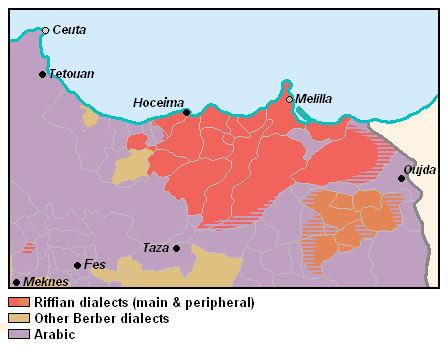Region Rif | Ethnicity Riffians | |
 | ||
Native to Morocco, Melilla (Spain), Algeria Native speakers 1.5 million (2004 census) Language family Afro-Asiatic
Berber
Northern
Zenati
Riffian Standard forms Standard Moroccan Tamazight | ||
Riffian language
Riffian, Rif Berber, or Riffian Berber (native local name: Tmaziɣt, external name: Tarifit) is a Northern Zenata variety of the Berber language spoken by about 2.5 million Moroccans, mainly in the Rif provinces Al Hoceima, Nador, Driouch, Berkane, a minority language in Tangier, Oujda, Tetouan, and among Riffian migrant communities in western Europe.
Contents
- Riffian language
- Classification
- Geographic distribution
- Dialects
- Morocco
- Algeria
- Sounds
- Writing system
- References
Classification
Riffian is a Zenati Berber dialect which consists of various sub-dialects specific to each clan and of which a majority are spoken in the Rif region, a large mountainous area of Northern Morocco, and a minority spoken in the western part of neighbouring Algeria.
Geographic distribution
Riffian is spoken mainly in the Moroccan Rif on the Mediterranean coast and in the Rif mountains, with a large minority in the Spanish autonomous city of Melilla. There are also speakers of Riffian in Morocco outside the Rif region, notably in the rest of Moroccan cities where they compose a minority. The neighbour state of Algeria is also home to Rif minorities. A Riffian-speaking community exists in the Netherlands and Belgium as well as to a lesser extent other European countries. Its own speakers simply call it "Tamazight", a term also often applied in a broader sense to the Berber language across North Africa in general.
Dialects
Dialects include Arzew (Old Arzeu), Urrighel, and Igzennaian.
Iznasen (Iznacen, Beni Snassen) is counted as a dialect in Kossman (1999), but Blench (2006) classifies it as one of the closely related Mzab–Wargla languages.
Morocco
There is a large amount of dialectal variation in Riffian Berber; this can easily be seen using the dialect Atlas (Lafkioui, 1997), however Riffian compose a single language with its own phonetical innovations distinct from other Berber languages. Majority of them are spoken in Northern Morocco, this includes the varieties of Al Hoceima, Temsamane, Nador, Ikbadene (including Iznasen) and the more southernly variety in the Taza province. Besides Riffian, two other unrelated and smaller Berber languages are spoken in North Morocco : the Sanhaja de Srair and the Ghomara languages.
Algeria
A few Rifian dialects are or used to be in the western part of Algeria, notably by the Beni Snouss tribe of the Tlemcen, as well in Bethioua but also in various colonial districts Rifians started to emigrate to since the 19th century.
Sounds
Riffian's most noticeable differences from other Berber dialects are that:
These variations don't occur in the Riffian dialects of Ikebdanen and Iznasen.
Writing system
Like other Berber languages, Riffian has been written with several different systems over the years. Most recently (since 2003), Tifinagh has become official throughout Morocco. The Arabic script is not used anymore for writing Riffian Berber. The Berber Latin alphabet continues to be used unofficially online and in most publications in Morocco and abroad. However, unlike the nearby Tashelhit (Shilha), Riffian Berber has little written literature before the twentieth century.
